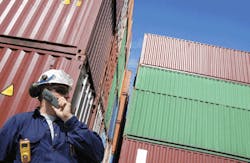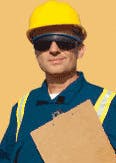Although this type of cargo was forbidden on a passenger flight, the canisters had been packed horizontally in cardboard boxes with bubble wrap and incorrectly labeled as "aircraft parts." The boxes were then placed in the plane's cargo hold and packed in a loose ring with several old airplane tires for support. The unstable packing is thought to have allowed the oxygen generators to ignite, causing a fire in the cargo area, and the subsequent crash.
See Also: Transportation & Distribution Logistics News & Analysis
Over the space of four months in 2010, three vessels that were loaded with either iron or nickel ore sank, killing 40 crew members in total. Although the cargo appeared solid and dry when loaded, the core structure of iron and nickel ore contained enough moisture to cause liquefaction under very wet conditions. Because these ships were transporting goods during monsoon season, when severe storms were encountered the moisture content of the ore increased, causing it to liquefy. The resulting water pressure shifted the cargo, making it unstable, and pulling the weight of the cargo to one side as the ship rolled. The loss of stability increased the list, causing the ships to capsize.
A shipping container filled with steel-belted rubber tires was discovered in the Monterey Bay National Marine Sanctuary after it was lost from a cargo ship during a storm in 2004. The company was ultimately held liable for more than $3 million in compensation due to the potential for environmental damage to the sanctuary. The ship lost 15 containers on that voyage, but none of the others was found. The loss of shipping containers at sea is not an uncommon occurrence, often caused when containers are improperly weight-labeled. Heavy units are then stacked very high, making them more liable to fall overboard.
What's so Special?
Although these incidents were caused by different factors, there is an underlying common feature. Each accident involved loads that required specialized handling procedures. In each case, serious outcomes resulted from incorrect labeling or weight indicators, hazardous materials not being identified, or unstable or careless packing. In fact, workplace load transfer accidents are a common cause of accidents and fatalities. Improper load management contributes to the loss of thousands of cargo containers from ships each year, and it is estimated that some 25 percent of truck accidents are caused by improperly secured cargo. Of even greater concern is the high number of fatalities caused by unsafe cargo handling, including materials prone to liquefaction or representing chemical hazards.
Managing, handling and moving loads would be a simple matter if everything fit neatly into a square box. Loads come in all sizes and shapes, however, each with unique characteristics, and they are transferred using multiple modes and methods, including truck, ship and rail. This can present some challenges when it comes to efficient, safe load transfer. Specialized loads require customized handling practices, specialized vehicles, special attachments and procedures and operator safety training. In short, specialized loads cannot be treated the same as regular loads. Doing so can cause significant loss, damage and harm to a company's finances. Even if there is no liability attributed, being associated with a disaster linked to careless handling of specialized loads can cause irreparable harm to any company.
Packaging
Packaging can take up 15% of a truck's load, and unusual shapes can cause space wastage, increasing handling and shipping costs. Proper packaging also involves how loads are secured. For example, transporting cars requires special tie-downs along with stress-free, controlled movement, so that no damage to undercarriage or vehicle is sustained.
Loading Docks
Unusual or specialized loads can require modifications to loading docks and special loading and unloading machinery. Hydraulic tailgate lifts and loading ramps, and loading dock lifts and load levelers may be required for heavy, awkward, or delicate loads. Machines such as skate tables, designed to load cargo like timber and steel for shipping, are often used.
Transfers and Conveyance Mechanisms
Forklifts are capable of handling many unusual loads. Special attachments such as carton, container, or appliance clamps, pole attachments, telescoping cranes, and hoppers are just a few of the forklift modifications that may be required.
Although forklifts are some of the most common types of machinery used for load transfers, many other mechanisms also come into play with specialized loads. Conveyor systems may be useful for oddly shaped items; heavy-duty roller conveyors can transport very heavy loads; and vertical or flexible conveyors can be adapted to different shapes and sizes. Prior to using a conveyor to move a product, however, it's important to determine compatibility of the product to the system. An overly heavy load or one that is awkwardly shaped may damage equipment or the product itself, incurring costly repairs and significant down time.
Storage
Unusual or specialized loads may mean specialized warehouse storage. Dry storage with high standards of cleanliness and pest control, temperature-controlled or refrigerated units, and explosion-proof or armored containers are just a few possible storage requirements, depending on the nature of the product.
Hazardous Materials
Many substances that are potentially hazardous, such as flammable gases, toxic substances and radioactive material, need specialized handling. But even substances not rated as hazardous could negatively impact the environment, should they be inadvertently released. Most countries have very specific regulations regarding handling hazardous materials, and transporting dangerous goods may require special equipment, such as explosion-proof vehicles.
Labeling and Paperwork
Accurate labeling and paperwork that meets regulatory standards is perhaps one of the most important considerations when managing specialized loads. Quality assurance standards must be followed. Specialized loads, especially those that involve hazardous materials, need to be clearly labeled so that they can be handled safely and in accordance with industry regulations. Paperwork needs to be tracked carefully; GPS tracking is particularly useful when shipping specialized loads.
Staff Training
It's important not only to ensure that employees are trained in handling and shipping specialized loads, but that companies used along the way maintain the same high standard of training. Training is mandatory in the use of specialized equipment, load lifting and rigging, and any special safety standards that may apply. Of particular importance is emergency response training. When shipping potentially hazardous material, a swift and effective emergency response can minimize costly damage, should an accident occur.
Safety
In addition to the above, other safety considerations include regular site and operations audits, and review of methodology and work processes to ensure compliance with relevant safety standards. By focusing on preventable actions and behaviors, with the target of zero harm, very high safety standards can be maintained.
Environmental Considerations
Although major cargo mishaps such as oil spills tend to receive a great deal of media attention, almost any accident involving hazardous or dangerous materials can have negative consequences to the environment. There are many ways environmental damage can occur when specialized loads are not shipped properly. Tens of thousands of shipping containers go missing from cargo ships and end up lost on the ocean floor, and there are few accountability measures currently in place; often the mishaps go unreported. The impact to the environment is largely unknown since the containers are never found. Miscellaneous contents, however, ranging from sneakers to Legos to hockey gear to car parts, have washed up on beaches around the world.
Finding efficient and cost-effective ways to manage unusual loads can mean a significant difference to your company's bottom line. If unusual loads can be bulk-shipped, cost savings can be attained and customer delivery streamlined.
Unusual loads that are packaged efficiently can be shipped by intermodal freight transport that do not require extra freight handling, when using multiple transportation modes across truck, rail and ship lines. Not only does this improve the speed of transport, it increases safety and security, and reduces the potential for damage and loss. Lost cargo of any kind is costly to a company, and mishaps when transporting specialized loads can have serious financial, social and environmental consequences.
Managing unusual or specialized loads efficiently requires careful thought and preparation. Following through on specialized handling procedures from start to finish will help a company ensure that its load will be handled properly at every step of the way, and will arrive at its destination safely and securely. The time invested will pay off in efficiency gains, improved productivity and minimized risk of loss.


